Sparring is essential if you want to become a complete fighter.
It is hands-down the best training method to improve your boxing, and I recommend that all boxers (not only aspiring fighters) spar regularly to keep their skills sharp. However, to a newbie, sparring can be very intimidating.
Watch two guys slug it out who have similar weight, experience, and who are both training to compete, and the intensity can be terrifying. It’s difficult to tell a hard spar apart from a real fight.
“Holy shit! Is that blood!?! They’re trying to kill each other.”
However, sparring doesn’t start off like this and may never reach that intensity for you – it depends on whether you ever wish to compete.
Even still, there’s something that doesn’t rest easy with you when it comes to sparring. It may be the thought of getting hit, the fitness required for it, or how complex it looks.
To help you overcome any fears and navigate the minefield of sparring, I’ve racked my brains to come up with these 34 boxing sparring tips for beginners (and a couple for the pros).
Some are common sense (which disappears in a flash when you’re getting punched), some were passed onto me, and some I’ve had to learn the hard way. The following advice covers everything from sparring etiquette to performance enhancing tips. Enjoy.
Sparring Games
Why not ease yourself into sparring with something more beginner friendly? Try one of these forms of sparring for an easy transition into the ring.
Jabs – Only allowing jabs means there’s much less to concentrate on.
Body Boxing – Normal boxing but you’re only permitted to hit from the shoulders down to the waist.
Slaps – Replace punching with slapping. Slaps isn’t played at full force, a gentle pat is all that’s required.
Burpee Tag – Here’s something fun that can also be used as a warm up. The object of burpee tag is to touch your partner’s knee or shoulder while they try to do the same. You are allowed to dodge attacks and parry your opponent’s hand. Every time you score, your partner has to do one burpee. It’s a game of skill and quick reflexes that’s also a lot of fun.
Touch Gloves
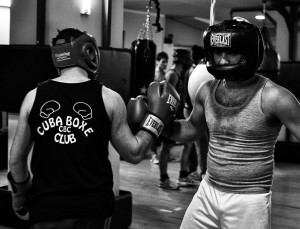
You should touch gloves with your partner at the beginning and end of each round. This is more sparring etiquette than a tip, but it will keep you on friendly terms with your gym buddies.
You do this to acknowledge that you are ready to spar, and to close each round and say thanks if you are rotating sparring partners. Touching gloves also reminds everyone that it’s a friendly sparring session and punching your partner’s lights out is not the objective.
Hit As Hard As You Get Hit
It’s easy to determine the intensity of a sparring session – match the power of your partner. In other words; give out as good as you’re getting.
This is a good rule of thumb that ensures you’re on par with everyone else in your sparring session, but it can be difficult for beginners to implement. You can be completely unaware of how hard you’re hitting, or you can get carried away momentarily.
If you suddenly get walloped with a ferocious punch, it’s probably your sparring partner keeping you in check. Take the hint, and turn the power down a notch.
Relax the Power, Practice Technique
Sparring is not about busting up the other guy. It’s an opportunity to practice what you’ve learned in a fight situation.
If all you try to do is take the other guy’s head off, your technique will become sloppy, and sooner or later, someone bigger and/or better will put you in your place.
In my opinion, a good sparring session has an intensity of 70% of full power.
Try Different Combinations
When you begin sparring, it’s easy to get yourself in a fluster. It’s complete information overload. You’re bundling months’ worth of training into a single two minute round as you try to hit a moving target while avoiding being hit.
It’s easy to switch into autopilot in this situation and just repeat the same, comfortable combinations.
However, if you want to improve (and keep your opponent guessing), you have to vary your combinations. If you followed tip number four and lowered the intensity, you should have no fear of trying something new.
Light and Fast
Sometimes it’s good to remove the power entirely and just work on speed and reflexes. Light and fast sparring allows you to practice techniques at lightning speeds without the threat of getting smacked with a haymaker.
Some people argue that tippy tappy sparring has no purpose, and you wouldn’t never fight like that whether in the ring or street. However, it works on your speed, agility, and both attack and defence, which are all elements of your overall fight game.
It’s also great for beginners to learn how to spar.
Slow Motion Sparring
Yes, it’s odd, but fighting Matrix style and going slo-mo can actually help your sparring.
It’s especially effective for beginners as it gives them time to process the incoming punch and choose which recently learned defence technique to apply. Don’t be scared to try it out, and as bizarre as it seems, it does work.
In fact, it’s so effective, Johnny from Expert boxing has named it his secret fight training method.
16oz Gloves Minimum
This isn’t so much a tip as it is a hard rule of sparring. Well, for me anyway.
If you’re sparring with gloves that weigh any less than 16oz, you’re putting your training partners at risk of injury. 8-10oz gloves are for fighting, 12-14oz gloves are for training, and 16oz and above are for sparring.
Better yet, if you buy actual sparring gloves, they’ll have soft padding that has been engineered to absorb the impact from punches.
If you need help deciding which boxing gloves to buy, then check out our buyer’s guide to boxing gloves.
Keep Your Stance
Keep a tight and proper stance at all times – chin tucked, eyes forward, hands up, elbows in and toes pointing towards your partner – but relax your muscles.
Relaxing in your stance is the key to keeping your form even when you’re exhausted.
Never Drop Your Hands
No matter how tired you are, never drop your hands!
It may be practice fighting, but you have to treat it like the real deal. If you let your guard slip during sparring, you can’t expect your partner not to take advantage and plant one on your nose.
In a fight, that’s exactly what would happen. There’s no rest, no compassion, and it may not even be a fair fight if it’s not in the ring.
Get into the habit of being in your guard even when you’re tired.
If you just can’t hold your hands up any longer and you need a quick shake, make sure that you are well outside your partners reach before doing so.
Don’t Look Away
The next habit you want to form is never looking away from your sparring partner during the round.
It totally makes sense and surely only an idiot would do such a thing, right? But you would be surprised how easy it is to briefly lose focus.
You’ll find yourself glancing at the round timer when you’re tired, or looking at your coach when he’s yelling instructions at you, or stopping to talk to your mate when he’s asking if you want a lift home.
All it takes is a quick lapse in concentration to finish the sparring session with a burst nose. Stay focused, and block out distractions. Shout out acknowledgments if you must, but don’t look away from your opponent.
Watch the Chest
So where should your eyes be?
The best place to focus is your partner’s chest. Don’t look at their eyes or their gloves – it can put you off your game.
If you focus on the chest, you’ll see your opponents overall movements and their shoulder rotations as the punch develops.
It will also naturally lead to you keeping your chin tucked in – one of the six fundamentals of a rock solid stance.
Fight Longer Rounds With Less Rest
If you’re training to compete, then train longer rounds than your fight. For example, if you’re fighting two-minute rounds with one-minute intervals, set the timer for three minutes with 30 seconds of rest when sparring. Come fight night, two-minute rounds will be a breeze, and you’ll be fully recovered with a minutes rest.
Even if you’re not planning on fighting anytime soon, this tip will work miracles for your fitness.
Don’t Apologise
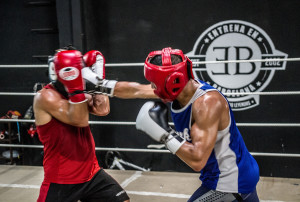
There’s nothing more annoying than a fighter that apologises every time he hits you in the face.
While manners are important, you can drop the politeness in the ring.
We’re sparring, if someone wasn’t getting hit, then we’re A) being pussies about it in fear of retribution, B) Both tired and throwing sloppy punches, or C) practicing fundamentally wrong technique. A) is unacceptable if you want to be a fighter, B) happens to the best of us, and if it’s C), you need to hire a boxing coach immediately.
So, unless you’ve accidentally gone too low on a punch, you shouldn’t apologise. Saying “sorry” for successfully doing what you’ve been training for makes no sense and pisses people off.
Hard Sparring
Although I think that 70% of full power makes for a good sparring match, there comes a time when hard sparring is necessary, such as when you’re training for a fight.
Cranking the intensity up to 90% or even 100% power will prepare you for actual fight conditions.
Common sense should prevail. Hard sparring should be with your head gear on, gum shield in, and in a ring (and under supervision) if possible – you don’t want to be bumping into gym equipment or other fighters.
Don’t Go In For The Kill
If you land a hard shot and your partners visibly rocked, stop the attack and let them recuperate. Do not go in for the kill. This isn’t a real fight. You should allow them to recover before continuing.
However, that being said, real fights aren’t conducted in this gentlemanlike fashion and if your partner has a fight coming up, you may feel it’s necessary to follow up after a hard punch to mimic fight conditions.
Experience (and common sense) will tell you when you need to stop or if it’s safe to continue.
Don’t Make Excuses
Nobody wants to hear that you’re exhausted, sick, injured, haven’t eaten enough, or didn’t sleep well last night. If it’s that bad, don’t come to sparring. Period.
We all have niggling pains or bad days once in a while. Using them as an excuse for poor performance is weak. Voicing whatever issues you’re facing doesn’t do anything but make you look like a pussy and grind down the people that have to listen to your crap.
No matter how bad you’re feeling, don’t complain, whine, or even think about your problems. And most importantly, never use excuses for subpar performance.
Be stoic in dealing with your issues, suck it up, and fight through it.
Train Like You’re Fighting
You shouldn’t treat your sparring sessions like a fight – that would be a quick way to get injured.
No, what I mean is that you should adopt the same practices and work ethic in training as you would have in a fight.
You want to adopt good practices like keeping your guard up, facing your partner, and being focused at all times a habit in training, so that it’s second nature to you when you step into the ring.
You also want to keep your work rate high. Seek to land more combos, or constantly maintain the pressure on your opponent even when you’re exhausted.
Train like you fight and live by the motto; “train hard, fight easy”, and you’ll be fully prepared for fight night.
Don’t Fight Dirty
This really shouldn’t need to be mentioned, but if you’re new to boxing, just know that you should never fight dirty. Keep it clean and fight fair, not just because you’re training with gym mates, but because you never want to stoop to that level.
This means no trying to land a haymaker after touching gloves, no cheap shots when breaking from the clinch, and abiding by the rules of boxing.
Don’t Release The Hulk
Nobody likes getting hit. It usually triggers shock, tears, or anger. However, when you’re sparring, you have to keep the rage monster in its cage.
Realise early on, that even though you’re kid on fighting, there are times when you’re going to take one in the chops. Shrug it off, don’t let your emotions get the better of you, and keep calm and keep sparring
Don’t Fear Getting Punched
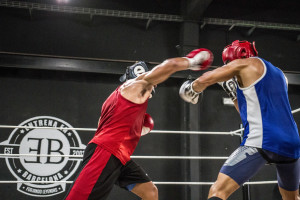
Now this one’s a hard one for newbies. It’s human nature to avoid pain and be anxious of anything that is going to cause us pain.
If we see a punch coming, our natural reaction is to flinch – unless you’re a boxer in which case you’ll naturally dodge, block, or counter. Understand that in boxing, it would be safe to bet the house on getting punched.
Although it’s extremely difficult and goes against your innate reactions, don’t cower away from punches. Accept that it’s going to happen – and even try to enjoy the feeling of being alive you get from being punched.
Once you’ve taken a few, you’ll realise that you’re not made of glass, and it doesn’t hurt as much as you were expecting.
Show No Pain
Never let on that you’ve been affected by a hard shot. If this was a real fight, showing any weakness gives your opponent the green light to go in for the knockout.
More importantly, don’t stop because you got hit. There is no “time-out”, keep swinging until you hear the buzzer, then assess the damage.
Unless it’s unbearable pain, stopping during a round is unacceptable. You’ll lose respect if you stop half way through a round and then you’re fine a minute later.
Fighters acknowledge taking a hard punch by remaining poker-faced, giving a small nod, or smiling. The last one really messes with your opponent.
“I just gave this guy my best shot and the crazy-son-of-a-bitch is smiling!?!”
Target the Head and Body
When beginners spar, they tend to focus primarily on the head. However, body shots are great for wearing down your opponent and are more than capable of winning a fight. Practice your body shots during sparring and mix up your combinations to target both the head and body.
Always Wear Your Gum Shield
You don’t always need to wear headgear or a cup when sparring, but you must never spar without your gum shield. Chipped or missing teeth and damaged nerve endings will cause you a world of pain, and dental work doesn’t come cheap.
Promises of keeping it light are also easily forgotten in the heat of the moment. Don’t risk the toothless hillbilly look. If you’ve forgotten your gum shield, keep your fight skills sharp by doing light and fast body boxing instead.
Stop When You’re Bleeding
Continuing to spar when you’re dripping blood all over the gym is not cool or macho in anyway. It’s disgusting and seriously unhygienic!
Depending on the severity of the blood flow you may be able to finish the round you’re on. But after that, tend to your war wounds immediately out of respect for your sparring partner, your gym, and the guy who cleans the gym floors.
Remember Your Manners
You should always thank your partner at the end of the sparring session to acknowledge their skills, effort, and for just being there to trade punches with you. A fist bump or even a man-hug is not out of place once the buzzer of the last round sounds.
There’s a special bond that’s formed between fighters when they come out the other end of an intense sparring session. Even if they were complete strangers before, they now have new found respect for one another.
Taking the time to say thanks and even talk about how the rounds went, techniques used, previous experience, or upcoming fights, could cement a friendship and ensure you’ve always got a sparring partner.
Don’t Forget to Breathe
Improper breathing is a quick way to gas-out. You should be breathing when you’re moving, throwing, and when you get hit. It doesn’t need to be a full, deep breath. A short, sharp exhalation when you perform a movement is enough.
You expel the air when you take a punch so that you can tense easily and so that you don’t get winded. Breathing out when you punch also ensures you don’t get winded from a counter punch.
The breathing is often accompanied by a short, hissing noise. It kind of sounds like “eeesshh”.
Relax
Sparring can be a stressful situation. Not only are you trying to implement all that you’ve learned against a moving target, but this target is also attempting to hit you. This often causes novices to keep their muscles in a constant state of tension which only leads to cramp and getting tired arms very quickly.
The secret is to relax and only tense up just before you take a shot, or when you throw.
It may feel unnatural at first, but the more you learn to get comfortable in a fight environment, the better your performance.
Keep Moving
You want to make yourself a difficult target to hit by keeping busy. Become an unpredictable fighter.
You don’t need to waste energy and bounce about like a mad man. A simple bob and weave with a few fakes thrown in will be enough to keep your partner guessing.
If you remain stationary, your partner can pick their shots, or they may even mistake your stillness for tiredness and go in for the kill.
Circle Away From the Power
You want to move in the opposite direction from your opponent’s power hand.
For example, if you discover your partner has a mean left hook, you want to keep circling left so when the left hook is thrown, it won’t have as much power. If you step right, then you’re walking straight into the force of the punch. However, don’t make it obvious and change directions every so often.
Note: the next three tips are for the more advanced guys. Even if you’ve never sparred before, still read them as there will come a time when they will apply to you.
Focus on Winning (advanced)
If you’re a beginner, you really shouldn’t be concerned about getting the better of anyone when sparring and you should concentrate on technique and relaxing.
But for those guys that are more experienced or are training for a fight, go in expecting to win every sparring round. This will keep your work rate up as you constantly seek to land more punches.
However, the greatest benefit is the effect it has on your mental psyche. It acts as a confidence booster, and when you’re winning the majority of your sparring rounds, you know you’re ready to fight.
Keep conditioning the mind to expect to win and take this positive attitude into the ring with you.
Don’t Beat-up Beginners (advanced)
No matter how good it feels to own someone in the ring, resist the temptation if that someone is a beginner.
When you spar with beginners, let them throw punches and get comfortable in the ring.
Everyone’s been the new guy at one point, and you’ll know first-hand the confusion and anxiety that accompanies the first few sparring sessions. Don’t crush the next wave of fighters by being overly brutal.
The occasional jab or small combo is sufficient to remind them to keep their guard up.
The exception to this rule is if the new guy is a dick, and after numerous warnings to lower the intensity, he still finds he can’t stick to 70% power. In this case, dishing out two black eyes is necessary for his “education” and to restore the pecking order.
Take the Time to Teach (advanced)
You may not be able to imagine it now, but there will come a time when aspiring boxers are hungry for your knowledge. Share your wisdom and give advice freely.
You won’t come across a know-it-all if you share your expertise when asked. People appreciate genuine and useful help.
If someone asks for pointers on their sparring or asks how you manage to keep catching them, take the time to show them.
Situational Sparring (advanced)
Situational sparring tackles the parts of your fight game you’re struggling with head on. To become a well-rounded fighter, you can’t neglect to work on your weaknesses. If you have a slow jab, instead of shying away from jabbing, seek to improve it by throwing nothing but jabs for an entire round. Or if you tend to clam up when you’re rushed into the corner, practice drills where you start in the corner and the objective is to fight your way out and regain control of ring centre.
Getting Good Takes Time
I want to finish on age-old advice passed onto me by my instructor. When I used to get pissed off at getting beat up by him (and countless others) he would remind me:
“You have to spend a long time being the nail before you can be the hammer.”
Becoming good at boxing takes time – we’re talking years of hard work and dedication. When you first start out, you will take a beating. It’s just the way this works.
However, don’t be put off, keep showing up and working on your fight game, and there will come a time when you get to swing the hammer.
Share Your Boxing Sparring Tips
I hope you’ve enjoyed these boxing sparring tips, and more importantly, I hope you put some of them to use.
If you’ve got any more, please share them in the comments below.
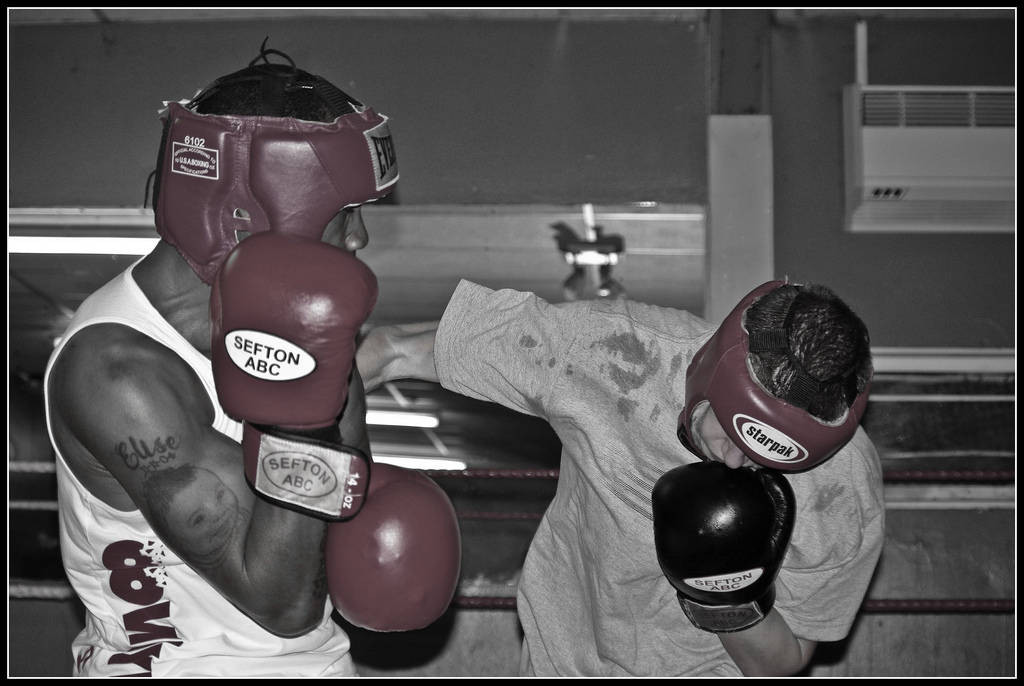
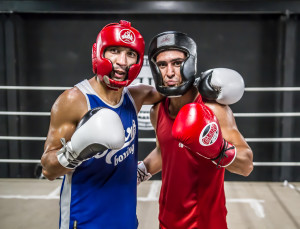
Excellent tips! Just to add, it is also important that you use appropriate boxing gloves when sparring. Here is my own tip when looking for the appropriate boxing glove. https://ringsideaus.com.au/2016/06/01/look-ideal-sparring-boxing-glove/
Top notch advice! Thanks for that. Some hot headed people would debate point #25 about stopping when you’re bleeding lol but it is true. Not only out of respect but also if you’re bleeding, it could indicate something serious if you’re not careful – obviously. When sparring, you shouldn’t waste any time on that. Again, great points.
Thanks for the comment, Jason. The hotheads that don’t stop are missing the point of sparring. We’re not out to kill each other; we’re training so that we can all learn and improve. Let the other guy get patched up, and then get back on into it. Nice site by the way. I only had a quick look around, but I’ll stop by and have a read of some of your posts soon.
Yeah , I definitely agree. Slow and steady wins the race, am I right? Thanks, Jamie! I appreciate that.
Absolutely 🙂